Jackfish (Trevally)
Carangidae

Photo by Rickard Zerpe / CC BY 2.0 via Wikimedia Commons
If the ocean had a motorcycle gang, jackfish would be the members - sleek, aggressive, and traveling in coordinated packs that terrorize smaller fish with ruthless efficiency. Also called trevally (especially in the Indo-Pacific), these powerful predators combine raw speed, tactical intelligence, and pack-hunting cooperation into one silver-bullet package. The Giant Trevally, apex of the family, is legendary for explosive strikes, acrobatic leaps out of the water to catch birds mid-flight, and fights so powerful they've broken fishing rods and even dislocated anglers' shoulders. For divers, witnessing a school of jacks working a baitball - silver torpedoes flashing through clouds of prey - is like watching a perfectly choreographed underwater blitzkrieg. They're not just fish; they're ocean athletes at the absolute peak of aquatic performance.
🔬Classification
📏Physical Features
🌊Habitat Info
⚠️Safety & Conservation
Identification Guide

Photo by TANAKA Juuyoh (田中十洋) / CC BY 2.0 via Wikimedia Commons
- Body Shape: Deep, laterally compressed body with steep head profile; extremely streamlined
- Forked Tail: Powerful, deeply forked tail fin for burst acceleration
- Scutes: Row of sharp, modified scales (scutes) along the tail - unique to jacks
- Pectoral Spot: Most species have a distinctive black spot at the base of pectoral fins
- Eye Size: Relatively large eyes for enhanced visual hunting
- Color Changes: Mature males can darken significantly, sometimes turning nearly black
- Species Variation: From smaller bigeye trevally (40cm) to massive GT (170cm, 80kg)
Top 10 Fun Facts about Jackfish (Trevally)
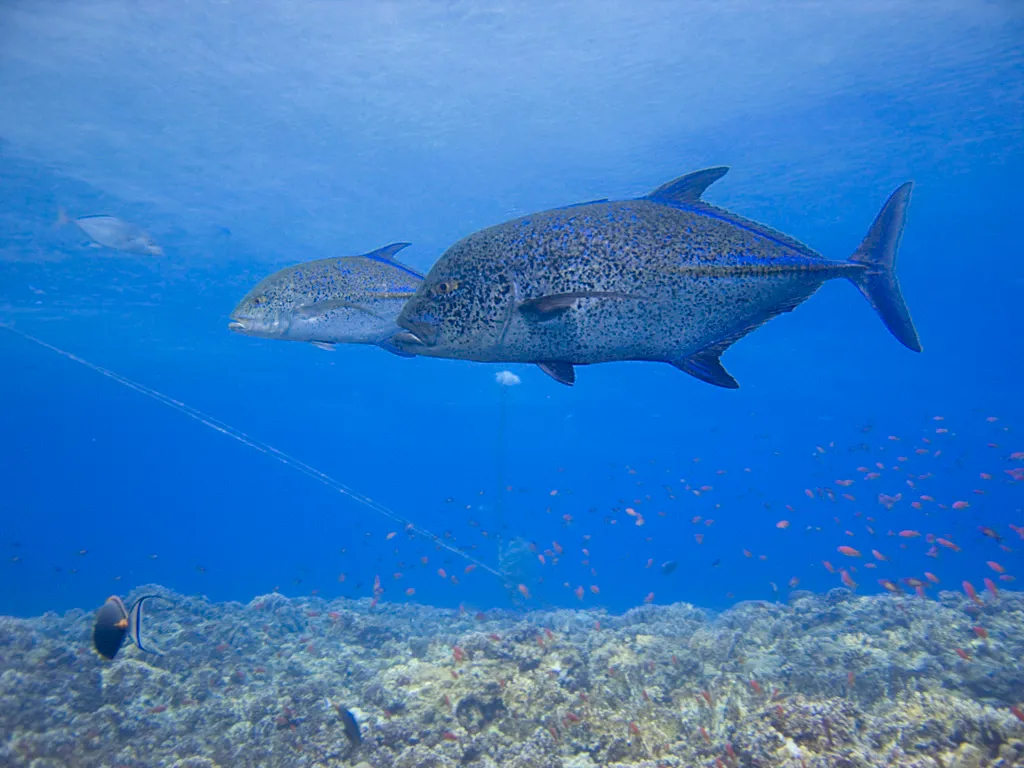
Photo by jon hanson from London / CC BY-SA 2.0 via Wikimedia Commons
1. The Ocean's Speed Demons: 60 km/h Bursts
Jackfish are built like aquatic race cars, capable of reaching speeds up to 60 km/h (37 mph) in short bursts. This incredible velocity comes from their streamlined, torpedo-shaped bodies, powerful tail muscles, and specialized muscle fiber composition optimized for explosive acceleration. Unlike endurance swimmers like tuna, jacks are sprint specialists - they don't maintain high speeds for long, but their initial burst is devastating. When a GT charges a prey fish, it closes the distance so fast that the victim has essentially zero reaction time. This speed also makes them formidable game fish; anglers report their initial runs as "freight train strikes" that can strip 100+ meters of line in seconds.
2. Airborne Assassins: Hunting Birds Mid-Flight
Perhaps the most spectacular hunting behavior of Giant Trevally is their ability to launch themselves out of the water to catch birds. On certain Pacific islands, GTs have learned to patrol shallow lagoons where terns and noddies hunt. When a bird swoops low over the water to catch a fish, the GT explodes from below in a perfectly timed leap, snatching the bird mid-air in a spray of water. This behavior demonstrates remarkable spatial awareness, timing, and learning - the GTs must calculate the bird's trajectory, time their jump, and execute the attack in a split second. The footage of GTs hunting birds has become iconic in nature documentaries, showcasing apex predation at its most dramatic.
3. Pack Hunters: The Baitball Blitzkrieg
While adult jacks are often solitary, they frequently form hunting coalitions to attack schools of baitfish with devastating coordination. Multiple GTs will work together to herd sardines, anchovies, or fusiliers into tight "baitballs" against the surface or reef walls. Once the prey is condensed, the jacks take turns charging through the ball, mouths open, creating explosions of silver scales and panicked fish. This cooperative hunting strategy is remarkably effective - a single jack might catch a few fish, but a coordinated group can decimate an entire school in minutes. Divers witnessing these attacks describe them as underwater tornados of silver chaos.
4. Social Opportunists: Using Other Predators as Tools
Giant Trevally have evolved clever hunting partnerships with other predators. They've been observed shadowing monk seals, sharks, and groupers, waiting for these hunters to chase prey from hiding spots. As the primary predator flushes fish from coral crevices or reef structures, the GT swoops in to grab the escaping prey - essentially using the other predator as an unwitting beater. This intelligent opportunism demonstrates advanced cognitive abilities and understanding of other species' hunting behaviors. Some GTs even follow human divers, using our presence to flush out fish!
5. The Gentle Giants Paradox: Shy Despite Their Power
Despite their fearsome hunting prowess, jackfish are generally shy and wary around divers. Their reflective silver bodies and alert nature mean they maintain distance, circling at the edge of visibility. This wariness is an adaptation to being apex predators that also occasionally get preyed upon by larger sharks - they're constantly vigilant. However, when focused on hunting or during spawning aggregations, they become less cautious and can approach quite close. This creates magical moments for underwater photographers when a school of normally skittish GTs becomes approachable during a feeding frenzy.
6. Size Matters: The Giant Among Giants
The Giant Trevally (Caranx ignobilis) is the largest species in the genus Caranx, with confirmed specimens reaching 170 cm (5.6 feet) and weighing over 80 kg (176 pounds). At this size, GTs are among the largest predatory reef fish and have few natural predators besides large sharks and occasionally groupers. Their massive size combined with speed creates incredible power - when a trophy-sized GT hits your lure, experienced anglers compare the strike to hooking a runaway car. These fish are so strong they bend heavy-gauge hooks and snap thick fishing lines like thread.
7. The Black Phase Phenomenon
Mature male Giant Trevally can undergo a dramatic color transformation, changing from their normal silver-gray to deep charcoal or jet black. This "black phase" is thought to be related to dominance, territory, or breeding condition. Black-phase GTs are particularly impressive to encounter underwater - instead of the typical reflective silver, you see a massive, dark predator cruising the reef like a submarine. The biological trigger for this color change isn't fully understood, but testosterone levels and social hierarchy likely play roles. Not all mature males go black, and some only show the coloration temporarily.
8. Scutes: Nature's Switchblades
One distinctive feature of all jacks is the row of sharp, modified scales called scutes running along the narrow part of their tail (peduncle). These armored plates make the tail more rigid and streamlined, reducing drag during high-speed swimming. But they also serve as weapons - when handling a landed jack, anglers can get nasty cuts from these razor-sharp scutes. For the fish, they provide protection for the vulnerable tail area and may even cause injury to attacking predators. Running your hand from head to tail on a jack feels smooth, but going tail to head feels like sandpaper with knife edges.
9. Spawning Spectacles: Mass Aggregations
During spawning season, GTs form impressive aggregations of hundreds of individuals over specific reef areas and channels. These gatherings represent some of the best opportunities for divers to see large numbers of trophy-sized GTs together. The fish become less wary during spawning, focused on reproduction rather than feeding or threat avoidance. Males compete for dominance, displaying darker coloration and aggressive posturing. The synchronized release of eggs and sperm creates visible clouds in the water. These spawning aggregations are predictable in timing and location, making them vulnerable to overfishing in some regions.
10. The Ultimate Game Fish: Breaking Tackle and Anglers
In sport fishing circles, the Giant Trevally holds legendary status as perhaps the most powerful fish pound-for-pound. Their combination of speed, strength, and fighting intelligence makes them devastating opponents. Stories abound of GTs breaking heavy-duty rods, straightening supposedly "unbreakable" hooks, and even causing physical injury to anglers. Their tactic of making sudden, violent direction changes and diving straight into reef structure (called "rocking") can snap 80-pound test line like sewing thread. Many seasoned anglers consider landing a trophy GT on light tackle their ultimate achievement - harder than landing a marlin or tuna twice its size.
Diving & Observation Notes
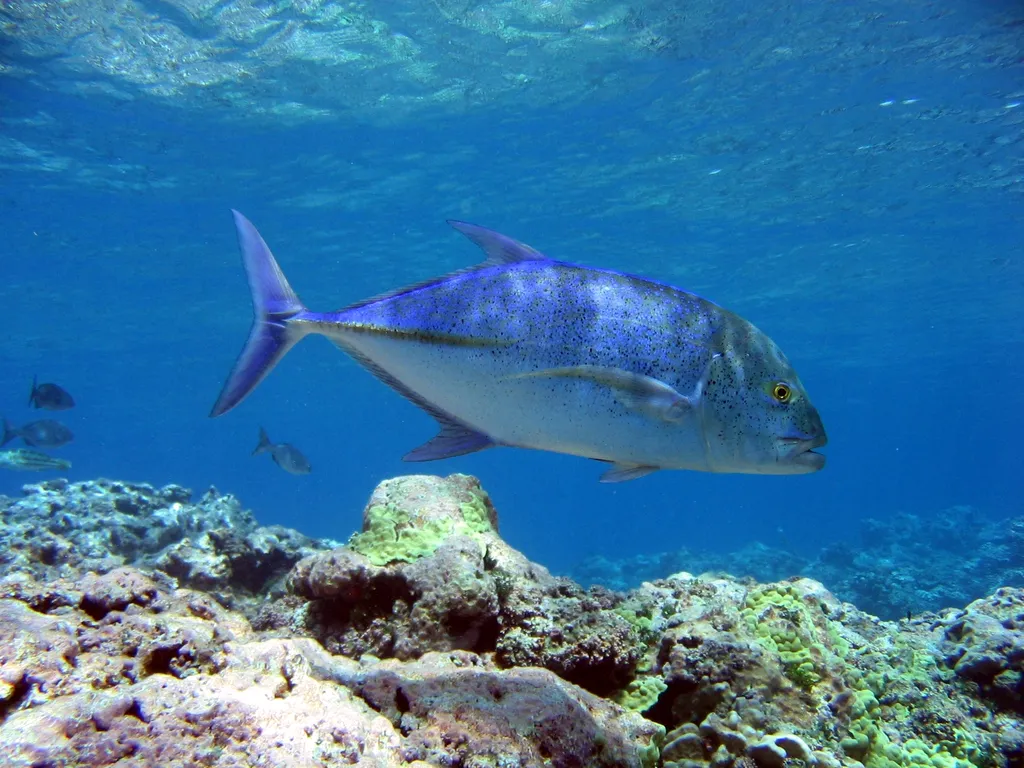
Photo by Dr. Dwayne Meadows via Wikimedia Commons
Finding Jackfish on the Reef
Jacks are dynamic hunters that utilize different zones of the reef:
- Reef edges and drop-offs: Prime hunting territory where jacks ambush fish moving between deep and shallow water
- Channels with current: Jacks position themselves to intercept fish being swept through passages
- Lagoon entrances: High fish traffic areas at dawn and dusk
- Surface activity: Watch for disturbed water, jumping fish, or diving seabirds - signs of jacks attacking baitfish below
Best Times for Encounters
- Dawn and dusk: Peak feeding activity for most jack species
- Incoming tide: Brings baitfish into lagoons and channels
- Spawning season: Location-specific, but creates massive aggregations (research local timing)
- Full moon phases: Often triggers increased activity and spawning
Observing Hunting Behavior
If you're lucky enough to witness jacks hunting:
- Baitball attacks: Stay calm and neutral in the water. Jacks are focused on prey and will often ignore divers, allowing close observation.
- Coordinated hunting: Watch how individuals take turns striking - there's a clear pattern to who attacks when.
- "Booming" sounds: Experienced divers report hearing deep "boom" sounds during attacks - this is fish impacting the reef or schools scattering in panic.
- Follow the silver flashes: Those rapid streaks of silver are jacks making attack runs - try to position yourself to capture the action.
Photography Tips
- Fast shutter speed: Minimum 1/250s, preferably 1/500s or faster to freeze the action
- Wide angle for schools: Capture the scale and chaos of coordinated attacks
- Strobe positioning: Side-light to make silver scales shimmer; avoid direct frontal flash which creates too much reflection
- Anticipation: Jacks are too fast to react to - watch their pattern and position yourself where they'll pass
- Silhouettes: Shoot upward with jacks between you and surface for dramatic silhouettes
Safety and Behavior
Jackfish pose virtually no threat to divers:
- No aggression: Despite their powerful hunting, jacks don't attack humans
- Curious but cautious: They may approach to investigate, especially if you're spearfishing (never a good idea in jack territory!)
- Maintain distance: Respect their space; they're more likely to stay nearby if you don't chase
- During feeding frenzies: Stay clear of the actual baitball - you won't be attacked, but a high-speed GT is solid muscle and could accidentally collide with you
Spearfishing Warning
If you spearfish in areas with jackfish:
- Jacks will definitely investigate your catch - the vibrations and blood attract them
- GTs have been known to steal fish right off spears
- Some have even bitten down on the spear itself while trying to grab the fish
- Always keep your catch secured and be aware of approaching jacks
- Consider this before spearfishing in GT territory!
Conservation Awareness
- Spawning aggregations are extremely vulnerable to overfishing - one bad fishing pressure can devastate a population
- GTs and other large jacks are slow-growing and late-maturing, making populations slow to recover
- In some regions, GT numbers have declined significantly due to sport fishing and commercial harvest
- Practice catch-and-release for trophy fish
- Report spawning aggregation sites to marine protected area managers
- Never disturb spawning aggregations for photography - observe from distance
Best Places to Dive with Jackfish (Trevally)

Great Barrier Reef
The Great Barrier Reef stretches for more than 2,300 km along Australia’s Queensland coast and is Earth’s largest coral ecosystem. With over 2,900 individual reefs, hundreds of islands, and a staggering diversity of marine life, it’s a bucket‑list destination for divers. Outer reef walls, coral gardens and pinnacles support potato cod, giant trevallies, reef sharks, sea turtles, manta rays and even visiting dwarf minke and humpback whales. Divers can explore historic wrecks like the SS Yongala, drift along the coral‑clad walls of Osprey Reef or mingle with friendly cod at Cod Hole. Whether you’re a beginner on a day trip from Cairns or an experienced diver on a remote liveaboard, the Great Barrier Reef offers unforgettable underwater adventures.

Raja Ampat
Raja Ampat, the “Four Kings,” is an archipelago of more than 1,500 islands at the edge of Indonesian West Papua. Its reefs sit in the heart of the Coral Triangle, where Pacific currents funnel nutrients into shallow seas and feed the world’s richest marine biodiversity. Diving here means gliding over colourful walls and coral gardens buzzing with more than 550 species of hard and soft corals and an estimated 1,500 fish species. You’ll meet blacktip and whitetip reef sharks on almost every dive, witness giant trevally and dogtooth tuna hunting schools of fusiliers, and encounter wobbegong “carpet” sharks, turtles, manta rays and dolphins. From cape pinnacles swarming with life to calm bays rich in macro critters, Raja Ampat offers endless variety. Above water, karst limestone islands and emerald lagoons provide spectacular scenery between dives.

Maldives
Scattered across the Indian Ocean like strings of pearls, the Maldives’ 26 atolls encompass more than a thousand low‑lying islands, reefs and sandbanks. Beneath the turquoise surface are channels (kandus), pinnacles (thilas) and lagoons where powerful ocean currents sweep past colourful coral gardens. This nutrient‑rich flow attracts manta rays, whale sharks, reef sharks, schooling jacks, barracudas and every reef fish imaginable. Liveaboards and resort dive centres explore sites such as Okobe Thila and Kandooma Thila in the central atolls, manta cleaning stations in Baa and Ari, and shark‑filled channels like Fuvahmulah in the deep south. Diving here ranges from tranquil coral slopes to adrenalin‑fuelled drifts through current‑swept passes, making the Maldives a true pelagic playground.

Palau
Rising out of the western Pacific at the meeting point of two great oceans, Palau is an archipelago of more than 500 jungle‑cloaked islands and limestone rock pinnacles. Its barrier reef and scattered outcrops create caverns, walls, tunnels and channels where nutrient‑rich currents sweep in from the Philippine Sea. These flows feed carpets of hard and soft corals and attract vast schools of jacks, barracudas and snappers, as well as an impressive cast of pelagics. Grey reef and whitetip sharks parade along the legendary Blue Corner; manta rays glide back and forth through German Channel’s cleaning stations; and Ulong Channel offers a thrill‑ride drift over giant clams and lettuce corals. Between dives you can snorkel among non‑stinging jellyfish in Jellyfish Lake or explore WWII ship and plane wrecks covered in colourful sponges.

Sipadan & Semporna
Sipadan Island off the coast of Sabah is Malaysia’s crown jewel of diving – a steep limestone pinnacle rising more than 600 metres from the sea floor and teeming with pelagic life. Currents sweep past vertical walls encrusted in hard and soft corals, bringing in barracudas, jacks, reef sharks and bumphead parrotfish in breathtaking numbers. Nearby Mabul and Kapalai offer an entirely different experience on shallow sand‑slope reefs and artificial structures, where flamboyant cuttlefish, frogfish, mandarin fish and other macro critters hide among sponges and tyres. With limited daily permits, a visit to Sipadan is a privilege; most divers base themselves in the frontier town of Semporna or at water‑bungalow resorts on Mabul and Kapalai and make day trips into the park.
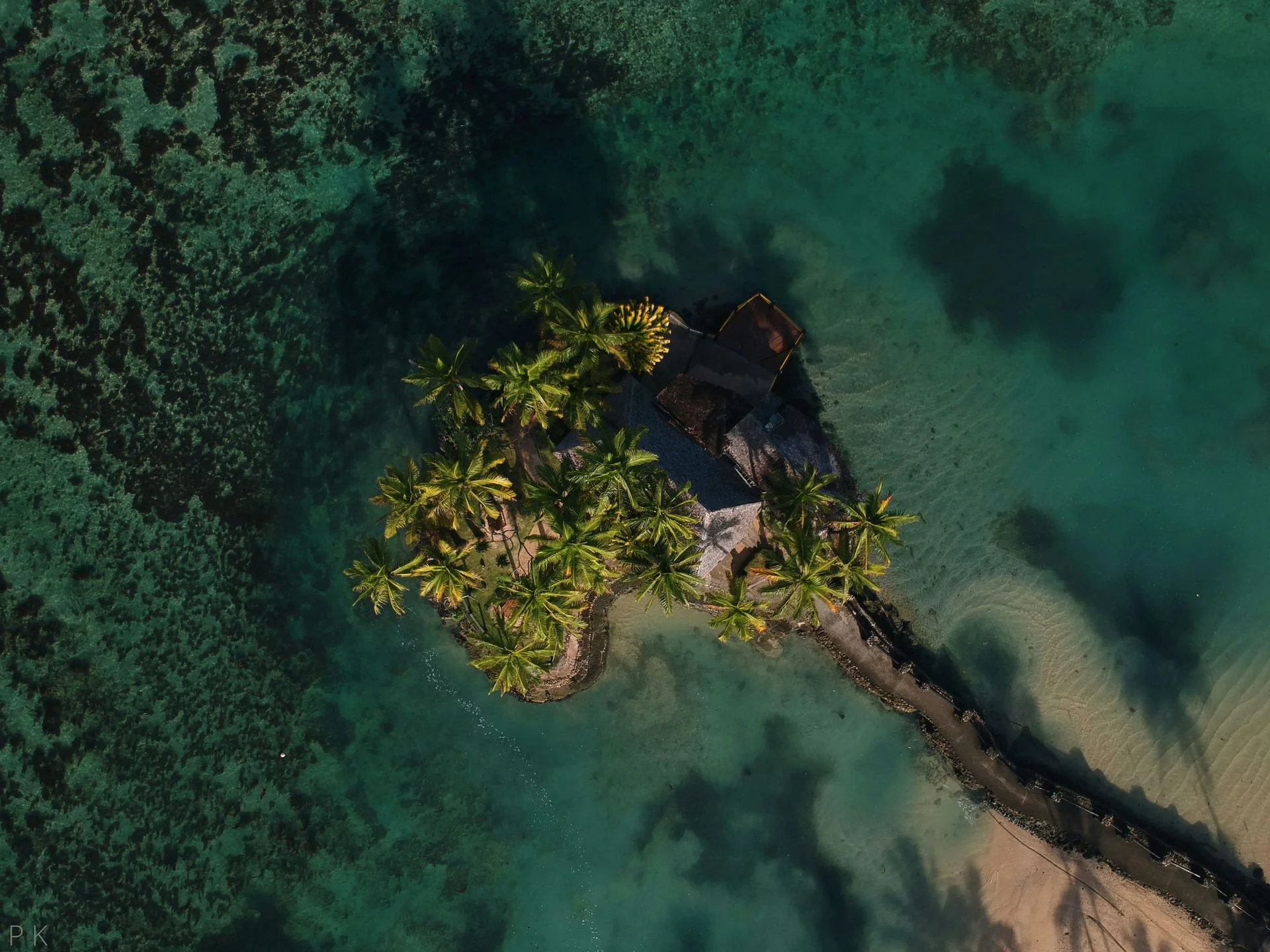
Fiji
Fiji sits like a necklace of more than 300 inhabited islands and 500 smaller islets in the heart of the South Pacific. Jacques Cousteau dubbed it the “soft coral capital of the world” for good reason – nutrient‑rich currents wash over sloping reefs, walls and bommies that erupt in shades of pink, purple, orange and yellow. The country’s dive sites range from kaleidoscopic coral gardens and pinnacles in the Somosomo Strait to shark dives in Beqa Lagoon, and remote passages in Bligh Water and the Koro Sea. Schools of barracuda, trevally and surgeonfish cruise above while manta rays, turtles, bull sharks and occasionally hammerheads glide past. Friendly locals and a relaxed island vibe make Fiji a favourite for both adventurous liveaboard trips and leisurely resort‑based diving.
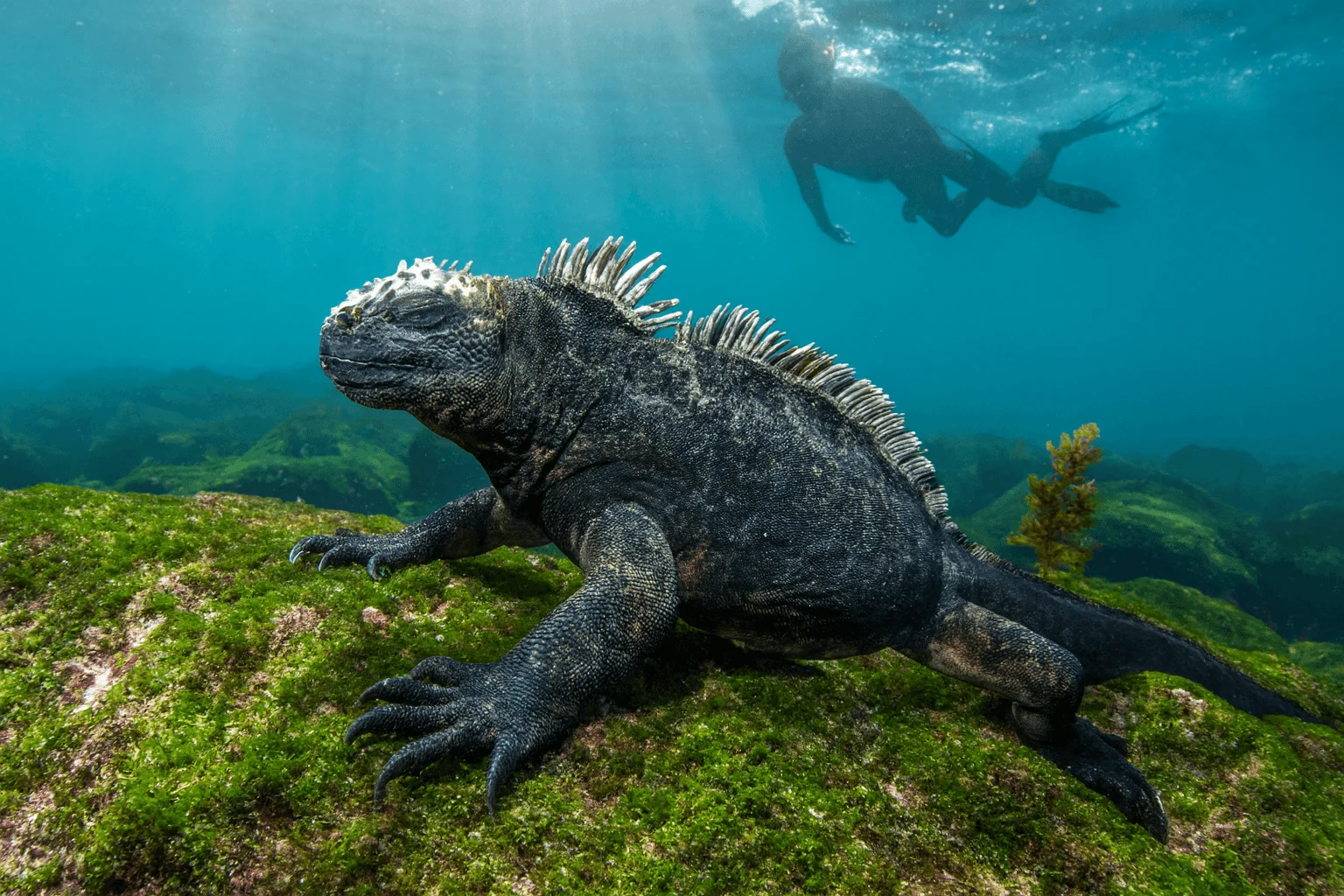
Galapagos
The Galápagos Islands sit 1 000 km off mainland Ecuador and are famous for their remarkable biodiversity both above and below the water. Created by volcanic hot spots and washed by the converging Humboldt, Panama and Cromwell currents, these remote islands offer some of the most exhilarating diving on the planet. Liveaboard trips venture north to Darwin and Wolf islands, where swirling schools of scalloped hammerheads and hundreds of silky and Galápagos sharks patrol the drop‑offs. Other sites host oceanic manta rays, whale sharks, dolphins, marine iguanas, penguins and playful sea lions. Strong currents, cool upwellings and surge mean the dives are challenging but incredibly rewarding. On land you can explore lava fields, giant tortoise sanctuaries and blue‑footed booby colonies.

Komodo
Komodo National Park is a diver’s paradise full of marine diversity: expect healthy coral gardens, reef sharks, giant trevallies, countless schools of fish, and frequent manta ray sightings at sites like Manta Point and Batu Bolong. Drift dives and dramatic reef structures add excitement, while both macro lovers and big-fish fans will find plenty to love. Above water, the wild Komodo dragons roam, giving a touch of prehistoric wonder to the whole trip.
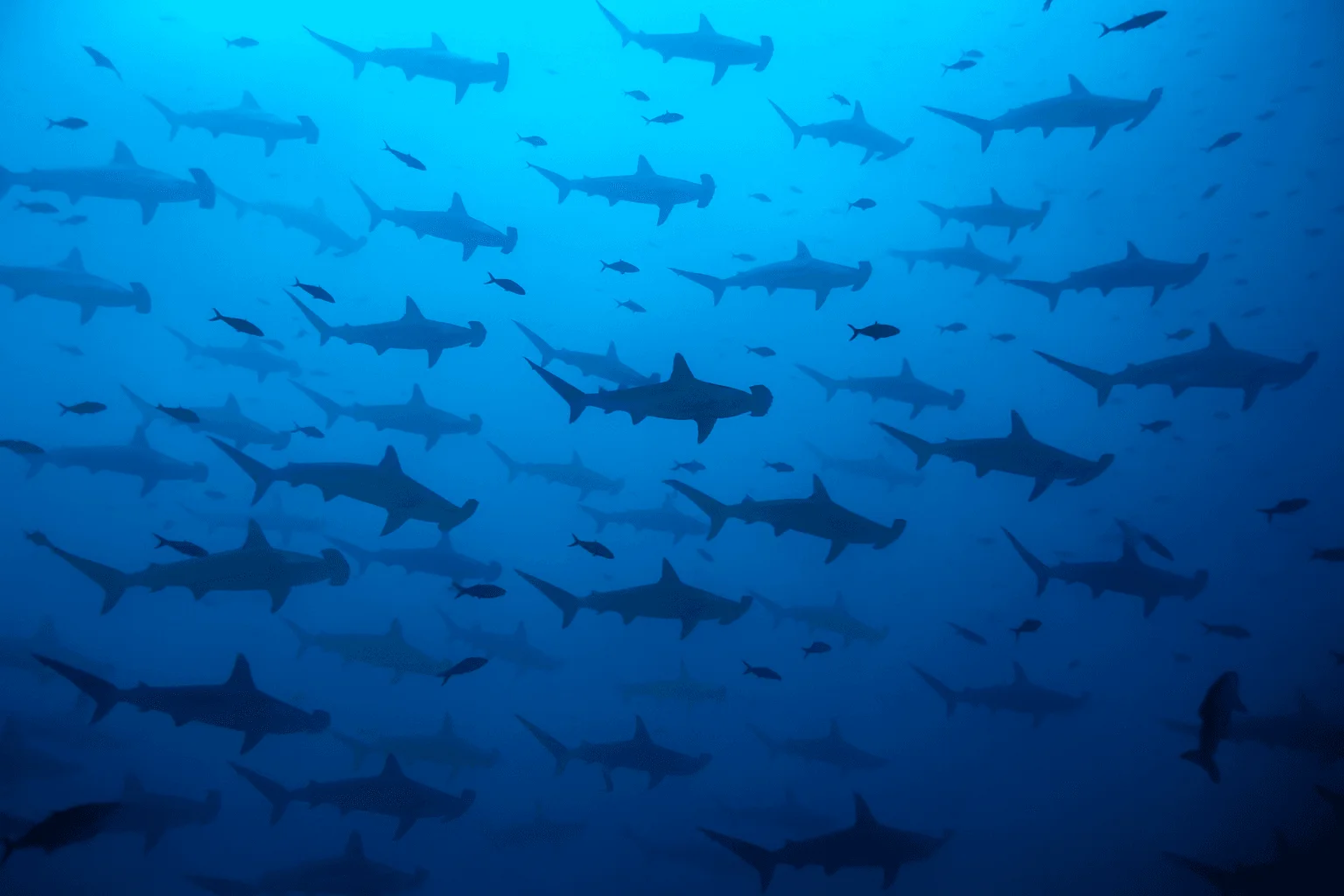
Cocos Island
Cocos Island sits 550 km off Costa Rica’s Pacific coast and is only accessible by liveaboard. This uninhabited, jungle‑clad island was described by Jacques Cousteau as “the most beautiful island in the world.” Divers come here for the pelagic action: schooling scalloped hammerheads patrol the reef points and pinnacles, tiger sharks and Galápagos sharks cruise the blue, and manta rays and whale sharks glide past during the wet season. Visibility and sea conditions vary with the seasons, but the island’s underwater topography of walls, cleaning stations and steep pinnacles makes every dive an adventure. Currents can be strong and depths often exceed 30 m, so Cocos is considered an advanced destination. Trips are normally 9–10 days with a 36‑hour crossing each way from the mainland, and most operators include guided island hikes between dives.